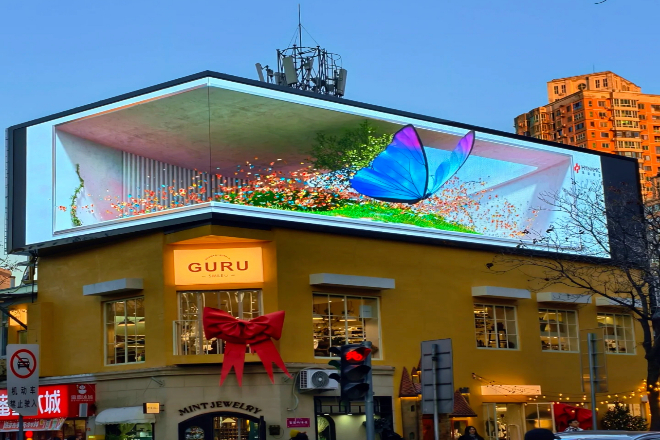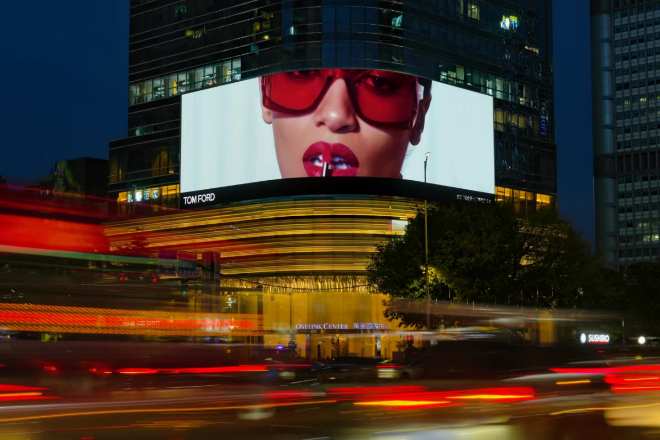序章

日常生活では、 屋外用LEDディスプレイスクリーン 常に新しい情報を提供してくれます。しかし、屋外環境の光は予測不可能であり、観客の距離や視野角も異なります。
屋外用 LED ディスプレイ スクリーンがさまざまな環境で最適な表示効果を発揮し、同時にエネルギー消費を節約できるようにする方法は、業界内外の共通の関心事となっています。この問題を解決するために、自動輝度調整技術が誕生しました。
1. 屋外用LEDディスプレイスクリーンの明るさ調整の基本ニーズ
輝度 屋外 LED ディスプレイ スクリーンの調整は、多くの要素を総合的に考慮して、エネルギー効率とユーザー エクスペリエンスを考慮しながら、さまざまな環境条件下で最高の視覚効果を提供できるようにする必要があります。
1). 屋外環境の複雑さ:
- 光は大きく変化します:
屋外環境の光の状態は、晴れた日の強い日差しから曇りの日の柔らかな光、そして夜の暗闇まで、天候、時間、季節によって変化します。
どのような照明条件下でもコンテンツが明瞭に表示されるようにするには、LED ディスプレイ画面の明るさをこれらの変化に応じて自動的に調整できる必要があります。
- 観客の距離はさまざまです:
屋外の LED ディスプレイ スクリーンは、近くの歩行者から遠く離れた車の乗客まで、さまざまな距離にいる視聴者にサービスを提供できます。
そのため、ディスプレイの明るさは、遠くにいる視聴者にもコンテンツをはっきりと見ることができるほど十分に高くする必要がありますが、同時に、近くの視聴者に過度な光刺激を与えないようにすることも必要です。
2). 視覚効果とエネルギー消費のバランス:
- 表示効果を確保する:
屋外の LED ディスプレイは、特に強い光のある環境でも、コンテンツの鮮明さと視認性を確保するために十分な明るさが必要です。ただし、明るさが高すぎると、エネルギーが無駄になるだけでなく、視聴者の目に不快感を与える可能性があります。
- エネルギー消費の削減:
環境意識の向上に伴い、エネルギー消費の削減が重要な考慮事項となっています。
インテリジェントな明るさ調整システムにより、実際の周囲光と視聴者のニーズに応じてディスプレイの明るさを自動的に調整できるため、エネルギーの無駄が削減され、ディスプレイ効果が確保されます。
3). ユーザーエクスペリエンスの向上:
- 視覚疲労を避ける:
明るすぎたり暗すぎたりするディスプレイを長時間見続けると、視覚疲労を引き起こします。適切な明るさ調整により、視聴者は長時間見ても快適に過ごせます。
- 反射の問題:
屋外環境では、太陽光、水面、建物などにより反射が生じ、ディスプレイの視認性に影響する場合があります。反射防止素材と適切な明るさ設定を採用することで、視聴体験に対する反射の影響を軽減できます。
- 視聴の快適性を向上:
明るさ、コントラスト、彩度などの要素を総合的に考慮し、インテリジェントな調整システムを通じて最高の視覚効果を実現し、視聴者の視聴快適性を向上させます。
2.屋外LEDディスプレイの自動輝度調整技術の動作原理

1). ハードウェアレベル
1.1) 光センサやその他のセンサの応用
- フォトセンサー:小さな光検出器のように、周囲の光の強度を感知し、その情報を電気信号に変換します。
1.2) 正確な回路設計とコントローラ
回路設計: この回路は、ディスプレイ画面の「送信機」のようなものです。センサー信号をコントローラーに送信し、コントローラーの指示を各ピクセルに送信する役割を担っています。
コントローラ: コントローラーはディスプレイ画面の「司令官」のような存在です。センサーからの信号を受信して、明るさの調整方法を決定し、回路に指示を出します。
1.3) 電流制御とパルス幅変調(PWM)
現在の規制: LED ライトは小さな電球のようなものです。流れる電流が大きいほど、明るくなります。電流を調整することで、LED の明るさを制御できます。
パルス幅変調(PWM): この技術は、電球のオンとオフの時間を素早く調整して明るさを制御します。LED の場合、オンとオフを素早く切り替えることで明るさを制御します。
2). ソフトウェアレベル
- ディスプレイ制御システムの明るさ調整機能:
この機能はインテリジェントなアシスタントのようなものです。外光、時間、またはユーザーのニーズに応じてディスプレイの明るさを自動的に調整し、より快適に視聴できるようにします。
- 自動明るさバランスを実現する組み込みアルゴリズム:
このアルゴリズムはスマートレギュレーターのようなものです。ディスプレイの各部分を適切な明るさに保ち、一部の場所が明るすぎたり、一部の場所が暗すぎたりすることを防ぎます。
- インテリジェント照明技術:
この技術は非常にスマートです。ディスプレイの内容を認識し、明るくする必要がある場所だけを明るくし、明るくする必要のない場所を少し暗くすることで、エネルギーを節約します。
3). 具体的な実施プロセス
- 感光センサーは周囲の光の強度情報を収集します。
感光センサーは小さな観察者のようなものです。常に周囲の光を観察し、情報を収集しています。
- センサーは光信号を電気信号に変換し、それをマイクロコントローラまたはメイン制御チップに送信します。
センサーは収集した光情報を電気信号に変換し、それを「司令官」であるマイクロコントローラーまたはメイン制御チップに送信します。
- マイクロコントローラまたはメイン制御チップは信号を処理し、事前に設定されたアルゴリズムに従って適切な明るさ調整値を計算します。
信号を受信すると、「コマンダー」は事前に設定されたアルゴリズムとルールに従って適切な明るさの値を計算します。
- 駆動回路を制御することで、LED ディスプレイの明るさを調整します。
最後に、「コマンダー」は回路を通じて各ピクセルに明るさ調整の指示を送り、指示に従って明るさを調整できるようにします。
一般的に、屋外 LED ディスプレイの自動輝度調整技術は、ディスプレイにスマートな認識システムと制御システムをインストールするようなもので、環境に応じて輝度を自動的に調整できるため、視聴がより快適になり、エネルギーも節約できます。
3. 屋外LEDディスプレイの自動輝度調整技術の利点と応用
1). 利点
- 知的:
屋外 LED ディスプレイの自動輝度調整技術は、周囲の光の強度の変化に応じてディスプレイの輝度を自動的に調整できます。
つまり、手動操作を必要とせずに、ディスプレイはさまざまな照明条件下でも最適な視覚効果を維持できます。このインテリジェントな機能により、ディスプレイの自動化が向上するだけでなく、手動操作の煩雑さも軽減されます。
- 省エネと環境保護:
屋外 LED ディスプレイは、明るさを自動的に調整することで、視覚効果を確保しながらエネルギー消費を効果的に削減できます。
薄暗い環境では、ディスプレイの明るさが自動的に下がり、不要なエネルギーの浪費が削減されます。また、自動明るさ調整により光害も軽減され、周囲の環境に優しくなります。
屋外 LED ディスプレイを例にとると、自動輝度調整技術により、夜間の輝度は 30% 程度低下し、日中の光量に応じて適切な輝度に自動的に調整されます。
統計によると、この対策により、ディスプレイのエネルギー消費量が約20%削減され、効果的にエネルギーを節約できます。同時に、明るさを合理的に制御することで光害も軽減され、周囲の環境に優しくなります。
- 表示効果を向上させる:
屋外用 LED ディスプレイは、明るい日中でも暗い夜間でも、明るさを自動的に調整し、表示されるコンテンツの鮮明さと明るさを維持します。
この技術により、ディスプレイはさまざまな照明条件下で最高の視覚効果を発揮できるようになり、視聴者の視聴体験が向上します。
たとえば、スタジアムのアプリケーションでは、試合時間が昼夜にわたる可能性があるため、屋外 LED ディスプレイはさまざまな照明条件に対応する必要があります。
自動輝度調整技術により、ディスプレイ画面が強い光の下で光を反射せず、暗い光環境でもぼやけず、常に鮮明で明るい表示効果を維持し、視聴者に優れた視聴体験をもたらします。
- ユーザーエクスペリエンスの向上:
自動明るさ調整技術により、画面が明るすぎたり暗すぎたりすることによる視覚疲労や反射の問題を回避します。視聴者はいつでもどこでも快適で鮮明な視聴体験を楽しむことができます。
これにより、ユーザー満足度が向上するだけでなく、屋外 LED ディスプレイの魅力も高まります。
2). アプリケーションシナリオ分析
- 商用アプリケーション 屋外看板 情報公開画面:
商業分野では、屋外用LEDディスプレイの自動輝度調整技術が看板や情報発信スクリーンなどのシーンで幅広く活用されています。
これらのディスプレイは明るさを自動的に調整することで、さまざまな照明条件下でも最適な視覚効果を維持し、より多くの視聴者の注目を集めることができます。
同時に、自動明るさ調整により、エネルギーを効果的に節約し、運用コストを削減することもできます。
- スタジアム、コンサート、その他大規模イベント会場:
スタジアムやコンサートなどの大規模イベント会場では、屋外用LEDディスプレイは欠かせない情報表示ツールです。
自動輝度調整技術により、シーンの光の変化に応じてディスプレイ画面の輝度を自動的に調整し、観客がどの角度からでもゲーム画面やパフォーマンス内容をはっきりと見ることができるようになります。
これにより、観客の視聴体験が向上するだけでなく、シーンの雰囲気や効果も高まります。
- 交通標識、緊急避難指示、その他公共安全分野:
公共安全の分野では、交通標識や緊急避難指示などの場面でも屋外用 LED ディスプレイ スクリーンが広く使用されています。
自動輝度調整技術により、これらのディスプレイ画面はさまざまな照明条件下でも鮮明な表示効果を維持し、正確でタイムリーな情報ガイダンスを一般の人々に提供できます。
特に火災、地震、その他の災害などの緊急事態では、自動明るさ調整技術により、避難指示の明瞭性と視認性を確保し、一般市民の自力救助能力を向上させることができます。
4. 屋外用LEDディスプレイの自動輝度調整技術の開発動向と課題

1). 開発動向
- テクノロジーの統合:
今日の屋外 LED ディスプレイ スクリーンはますますスマートになり、モノのインターネットやビッグ データなどの最先端技術と「提携」し始めています。モノのインターネットを通じて、ディスプレイ スクリーンは遠隔から指示を受信し、光の強度などの環境データを収集できます。
ビッグデータはこれらのデータを分析し、明るさの調整をより正確にし、すべての人のニーズに沿うものにするのに役立ちます。将来的には、このテクノロジーの統合により、ディスプレイ画面がよりスマートになり、ユーザーをよりよく理解できるようになります。
- 精度の向上:
センサーとアルゴリズムの継続的な進歩により、屋外 LED ディスプレイの明るさ調整はますます正確になりました。
新しいセンサーは光の変化をより敏感に感知し、スマートなアルゴリズムは素早く反応して明るさを調整します。これにより、ディスプレイ画面は昼夜を問わず最高の視覚効果を維持できます。
2). チャレンジ
- 環境の複雑さ:
屋外環境の光は大きく変化します。晴れた日から暗い夜まで、光の強さと色が異なります。これはセンサーとアルゴリズムのテストです。
センサーはさまざまな光条件下で正確に機能する必要があり、アルゴリズムも突然の影や光の急激な変化などのさまざまな緊急事態に対応する必要があります。これには継続的な技術改善が必要です。
- 原価管理:
屋外用 LED ディスプレイの自動輝度調整技術は非常に先進的ですが、コストは低くありません。高精度のセンサーとインテリジェントなアルゴリズムは非常に高価で、生産コストが増加します。
そのため、性能を維持しながらコストをいかに削減するかが大きな課題です。今後は、この高度な技術をより多くの人に利用してもらうために、技術革新とコスト管理戦略に頼ってこの問題を解決する必要があります。
結論
要約すると、屋外 LED ディスプレイの自動輝度調整技術は、インテリジェント化、省エネ、環境保護、ディスプレイ効果とユーザーエクスペリエンスの向上などの利点を備え、屋外ディスプレイの分野でますます重要な役割を果たしています。
技術の継続的な進歩とアプリケーションの継続的な拡大により、自動輝度調整技術は周囲の光の変化にさらに正確かつ迅速に対応し、屋外 LED ディスプレイ スクリーンにさらに優れた表示効果とより低いエネルギー消費をもたらします。
最後に、LEDディスプレイスクリーンについてさらに詳しく知りたい場合は、 ご連絡ください。
